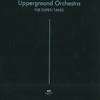Anyone who’s been seriously following exciting new techno developments over the past decade must have stumbled upon Rabih Beaini’s name at one point or another. An inquisitive musician, the Lebanese producer has been traveling a singular, esoteric journey into the depths of circuits and patch cords, showing an intriguingly strong familiarity with a broad spectrum of jazz history and proto-dance music repertoire as Ra.H and Morphosis. While debated about mostly in electronic dance music terms, it’s been clear that during his formative period in Venice, he was also diligently working out a way to incorporate the physicality of his modular gear in live improv practices. Reaching as far back as 2002, his lead position in the Upperground Orchestra heavily influenced various incarnations of the collective, and last year’s performance at Eupen Muzik Marathon in Belgium proves to be the most palpable document of the band’s sound. The Eupen Takes LP, released on Morphine Records’ live series this autumn, consists of those live recordings, split into six different tracks.
Side A opens with “Born Again,” an introduction to Upperground Orchestra: with Beaini’s series of sustained cosmic squeaks and Tommaso Cappellato’s basic rhythmic grid, the band quickly establishes a sluggish primal unity. Piero Bittolo Bon plays the flute at first, precariously building the background to an inevitable, tempo-shifting collapse, catalyzed by Alvise Seggi’s riotous bass playing. “Memory Shark,” firmly rooted in a quasi-disco backbone, brings exhilarating analog whooshes and is enlivened by lightning-fast psychedelic alto sax excursions, creating a genuine surprise and excitement. The band’s improvisations flow and grow in what seems an organic rather than calculating way, revealing a collective playing that deals not in any macro narrative, but clusters of micro-events. This fact becomes most evident in “Distorted Spread,” which is basically a cosmic rock jam founded on Cappellato and Seggi’s groovy frame, allowing Beaini and Bittolo Bon to celebrate the simultaneous co-existence of their innumerable musical options, moving among them with dazzling fluency.
Side B generally shows more order in handling of their sound, with more seamless joints and smooth, logical shifts in momentum. Although “Into The Dust” gives an innocent impression of a short sketch, it’s actually a mark of collective genesis: the Lebanese producer changes analog envelopes, accents and filters, oscillating through different sonorities to achieve specific gestural effects, which function as triggers for a prevailing theme for others — in this case Seggi. The soundscape on the LP mostly works as proof of primacy of sound over melody, but in “We Travel The Lands Of Starts And Dust,” the Orchestra offers a skillful interplay between Beaini’s serrated analog fluttering and ominous purrs, and Seggi’s sombre alternating slurs of bass, culminating into a deeply hypnotic kosmische trip. The volubility of the players and their skill at restless interweaving really seals the deal on the final cut, “Kamanja,” where we witness a balanced, synchronized melting pot of decentered tribal drumming, psychotic alto sax cries, sustained bleeps and bass interventions, which — in the last minute — burst into a killer riff.
The music on this LP often evolves according to its own logic, both improvisatory and hallucinatory, and its 40 or so minutes include softness and abrasiveness, restraint and attack, pulse and drift. It requires an open-minded listener attuned to the frequencies of this esoteric band, which might be hard to pinpoint. But just as there are various ways to make music, there are also various ways of listening. You can choose to listen to this record in one of two ways: remain alert to the myriad complexities of each moment, or surrender to the journey and let yourself be carried along. I chose the first and ended up in the latter.















One of the most important Jazz album for the next generations!